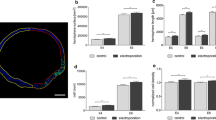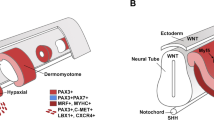Abstract
Beta-thymosins constitute a group of small actin-sequestering peptides. These highly conserved peptides are involved in cytoskeleton dynamics and can influence different cell properties such as motility, substrate adhesion, shape and chemotaxis. As a marker for tumour metastasis, the mammalian thymosin beta15 is believed to have an important diagnostic relevance in cancer prognosis, although little is known about its physiological function. In order to study the role of thymosin beta15 avian in embryogenesis, we cloned the chicken and quail orthologues of thymosin beta15 and used the chicken as a model for vertebrate development. Avian thymosin beta15, the first known non-mammalian thymosin beta15-like gene, encodes a peptide that possesses a cysteine at position one after the methionine which is a significant difference compared to its mammalian counterparts. Thymosin beta15 avian expression starts at an early stage of development. The expression pattern changes rapidly with development and differs from that of the related thymosin beta4 gene. The most prominent expression domain is seen in developing muscles of limbs and trunk. Gain-of-function experiments revealed that thymosin beta15avian has a function in normal myotome development. Ectopic over-expression of thymosin beta15 avian leads to premature elongation of myotome cells trespassing segment borders. We conclude that thymosin beta15 avian has a still undescribed function in promoting myocyte elongation.






Similar content being viewed by others
References
Banyard J, Hutchinson LM, Zetter BR (2007) Thymosin beta-NB is the human isoform of rat thymosin beta15. Ann N Y Acad Sci 1112:286–296
Banyard J, Barrows C, Zetter BR (2009) Differential regulation of human thymosin beta 15 isoforms by transforming growth factor beta 1. Genes Chromosom Cancer 48:502–509
Bao L, Loda M, Janmey PA, Stewart R, Anand-Apte B, Zetter BR (1996) Thymosin beta 15: a novel regulator of tumor cell motility upregulated in metastatic prostate cancer. Nat Med 2:1322–1328
Bao L, Loda M, Zetter BR (1998) Thymosin beta15 expression in tumor cell lines with varying metastatic potential. Clin Exp Metastasis 16:227–233
Bednarek R, Boncela J, Smolarczyk K, Cierniewska-Cieslak A, Wyroba E, Cierniewski CS (2008) Ku80 as a novel receptor for thymosin beta4 that mediates its intracellular activity different from G-actin sequestering. J Biol Chem 283:1534–1544
Brand-Saberi B, Gamel AJ, Krenn V, Müller TS, Wilting J, Christ B (1996) N-cadherin is involved in myoblast migration and muscle differentiation in the avian limb bud. Dev Biol 178(1):160–173
Chakravatri A, Zehr EM, Zietman AL, Shipley WU, Goggins WB, Finkelstein DM, Young RH, Chang EL, Wu CL (2000) Thymosin beta-15 predicts for distant failure in patients with clinically localized prostate cancer-results from a pilot study. Urology 55:635–638
Cinnamon Y, Ben-Yair R, Kalcheim C (2006) Differential effects of N-cadherin-mediated adhesion on the development of myotomal waves. Development 133:1101–1112
Clark EA, Golub TR, Lander ES, Hynes RO (2000) Genomic analysis of metastasis reveals an essential role for RhoC. Nature 406:532–535
Dai F, Yusuf F, Farjah GH, Brand-Saberi B (2005) RNAi-induced targeted silencing of developmental control genes during chicken embryogenesis. Dev Biol 285:80–90
Dathe V, Brand-Saberi B (2004) Expression of thymosin beta4 during chick development. Anat Embryol 208:27–32
Dathe V, Gamel A, Männer J, Brand-Saberi B, Christ B (2002) Morphological left-right asymmetry of Hensen’s node precedes the asymmetric expression of Shh and Fgf8 in the chick embryo. Anat Embryol 205:343–354
Dhaese S, Vandepoele K, Waterschoot D, Vanloo B, Vandekerckhove J, Ampe C, Van Troys M (2009) The mouse thymosin beta15 gene family displays unique complexity and encodes a functional thymosin repeat. J Mol Biol 387(4):809–825
Eadie JS, Kim SW, Allen PG, Hutchinson LM, Kantor JD, Zetter BR (2000) C-terminal variations in beta-thymosin family members specify functional differences in actin-binding properties. J Cell Biochem 77:277–287
Friedl P, Wolf K (2009) Plasticity of cell migration: a multiscale tuning model. J Cell Biol 188:11–19
Gold JS, Bao L, Ghoussoub RA, Zetter BR, Rimm DL (1997) Localization and quantitation of expression of the cell motility-related protein thymosin beta15 in human breast tissue. Mod Pathol 10:1106–1112
Goldstein AL, Hannappel E, Kleinman HK (2005) Thymosin beta4: actin-sequestering protein moonlights to repair injured tissues. Trends Mol Med 11:421–429
Hamburger V, Hamilton HL (1951) A series of normal stages in the development of the chick embryo. J Morphol 88:49–92
Huang HC, Hu CH, Tang MC, Wang WS, Chen PM, Su Y (2007) Thymosin beta4 triggers an epithelial-mesenchymal transition in colorectal carcinoma by upregulating integrin-linked kinase. Oncogene 26:2781–2790
Huff T, Muller CS, Otto AM, Netzker R, Hannappel E (2001) Beta-Thymosins, small acidic peptides with multiple functions. Int J Biochem Cell Biol 33:205–220
Huff T, Otto AM, Mulle CS, Meier M, Hannappel E (2002) Thymosin beta4 is released from human blood platelets and attached by factor XIIIa (transglutaminase) to fibrin and collagen. Faseb J 16:691–696
Koutrafouri V, Leondiadis L, Ferderigos N, Avgoustakis K, Livaniou E, Evangelatos GP, Ithakissios DS (2003) Synthesis and angiogenetic activity in the chick chorioallantoic membrane model of thymosin beta-15. Peptides 24(1):107–115
Logan M, Tabin C (1998) Targeted gene misexpression in chick limb buds using avian replication-competent retroviruses. Methods 14:407–420
Mannherz HG, Hannappel E (2009) The beta-thymosins: intracellular and extracellular activities of a versatile actin binding protein family. Cell Motil Cytoskelet 66(10):839–851
Mannherz HG, Mazur AJ, Jockusch B (2010) Repolymerization of actin from actin: thymosin beta4 complex induced by diaphanous related formins and gelsolin. Ann N Y Acad Sci 1194:36–43
Mollinari C, Ricci-Vitiani L, Pieri M, Lucantoni C, Rinaldi AM, Racaniello M, De Maria R, Zona C, Pallini R, Merlo D, Garaci E (2009) Downregulation of thymosin beta4 in neural progenitor grafts promotes spinal cord regeneration. J Cell Sci 122(22):4195–4207
Nieto MA, Patel K, Wilkinson DG (1996) In situ hybridization analysis of chick embryos in whole mount and tissue sections. Methods Cell Biol 51:219–235
Philp D, Huff T, Gho YS, Hannappel E, Kleinman HK (2003) The actin binding site on thymosin beta4 promotes angiogenesis. Faseb J 17:2103–2105
Rodriguez-Niedenführ M, Papoutsi M, Christ B, Nicolaides KH, von Kaisenberg CS, Tomarev SI, Wilting J (2001) Prox1 is a marker of ectodermal placodes, endodermal compartments, lymphatic endothelium and lymphangioblasts. Anat Embryol 204:399–406
Ryu YK, Lee YS, Lee GH, Song KS, Kim YS, Moon EY (2012) Regulation of glycogen synthase kinase-3 by thymosin beta-4 is associated with gastric cancer cell migration. Int J Cancer 131(9):2067–2077
Scaal M, Gros J, Lesbros C, Marcelle C (2004) In ovo electroporation of avian somites. Dev Dyn 229:643–650
Smart N, Risebro CA, Melville AA, Moses K, Schwartz RJ, Chien KR, Riley PR (2007) Thymosin beta-4 is essential for coronary vessel development and promotes neovascularization via adult epicardium. Ann N Y Acad Sci 1112:171–188
Sosne G, Qiu P, Goldstein AL, Wheater M (2010) Biological activities of thymosin beta 4 defined by active sites in short peptide sequences. FASEB J 24(7):2144–2151
Theis S, Patel K, Valasek P, Otto A, Pu Q, Harel I, Tzahor E, Tajbakhsh S, Christ B, Huang R (2010) The occipital lateral plate mesoderm is a novel source for vertebrate neck musculature. Development 137(17):2961–2971
Williams BA, Ordahl CP (1994) Pax-3 expression in segmental mesoderm marks early stages in myogenic cell specification. Development 120:785–796
Yokoyama M, Nishi Y, Yoshii J, Okubo K, Matsubara K (1996) Identification and cloning of neuroblastoma-specific and nerve tissue-specific genes through compiled expression profiles. DNA Res 3:311–320
Acknowledgments
The authors want to thank Meike Ast-Dumbach, Günter Frank, Ellen Gimbel, Rana Houmany, Susanna Konradi, Lydia Koschny, Marion Otto, Ulrike Pein and Swantje Wulf for their excellent technical assistance, Kewal Krishan for fibroblast preparation and Alexander Bonafede, Fangping Dai, Rizwan Rehimi and Daniel Bemmerl for helpful support. The project was kindly supported by the EU’s 6th framework programme MYORES (511978) and by the DFG (BR 957/5-3 and GRK 1104 to B.B.-S.).
Author information
Authors and Affiliations
Corresponding author
Additional information
GenBank accession numbers: DQ 867000 and FJ 185173.
Electronic supplementary material
Below is the link to the electronic supplementary material.
418_2013_1156_MOESM1_ESM.tif
Supplementary Figure 1: Immunohistochemical detection of thymosin beta15. The photographs show transversal paraffin sections of a HH stage 22 chicken embryo, stained with first antibody against. Thymosin beta15 (a) and unstained negative control after omission of first antibody (b). The myotome (my), neural tube (nt), and limb bud mesenchyme (lb) are specifically and strongly stained for thymosin beta15 in (a). Bar: 200 μm (TIFF 45762 kb)
418_2013_1156_MOESM2_ESM.doc
Supplementary Table 1 Synopsis of thymosin beta15 avian expression in comparison with thymosin beta4 during avian development. The main difference is the mutually exclusive expression of thymosin beta15 avian in skeletal muscle and of thymosin beta4 in endothelia of blood vessels (DOC 30 kb)
Rights and permissions
About this article
Cite this article
Chankiewitz, V., Morosan-Puopolo, G., Yusuf, F. et al. A thymosin beta15-like peptide promotes intersegmental myotome extension in the chicken embryo. Histochem Cell Biol 141, 275–287 (2014). https://doi.org/10.1007/s00418-013-1156-z
Accepted:
Published:
Issue Date:
DOI: https://doi.org/10.1007/s00418-013-1156-z




